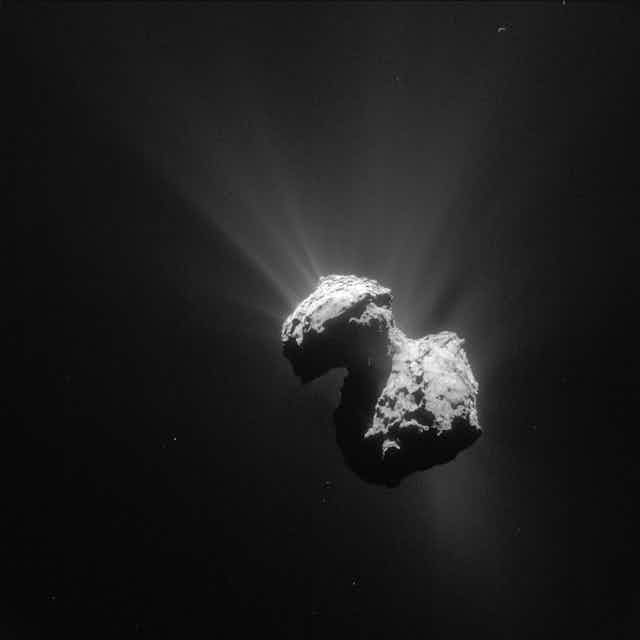Scientists have for the first time detected molecular oxygen (O2) in a comet’s coma, the cloud of gas surrounding it when it moves close to the sun. The discovery, which challenges our understanding of how the solar system formed, was made by the European Space Agency’s Rosetta spacecraft orbiting comet 67P/Churyumov-Gerasimenko .
The findings, published in Nature, came as a complete surprise to researchers.
Tracing the origin of O2
Oxygen is one of the most abundant elements in our galaxy and solar system, and we take the free molecular oxygen that makes up 20% of our atmosphere for granted with every breath. So why is finding oxygen in a comet such a big deal? Oxygen readily binds with other abundant elements such as hydrogen (H) or carbon ( C ) to form water (H2O) or carbon dioxide (CO2).
It takes some energy to split these molecules into their components again to produce free oxygen. The high levels of free oxygen in our atmosphere only persist because they are constantly replenished by the photosynthetic activity of the plant life on Earth. Our atmosphere is actually such an oddity that if a similarly oxygen-rich atmosphere was found around a planet orbiting a star other than the sun, the most likely explanation would in fact be life. But life has nothing to do with the oxygen on 67P. Though the comet contains some of the building blocks for life, it does not provide the conditions to assemble them.

We know that water, carbon monoxide and carbon dioxide are the dominant gases in the comas of comets. The authors of the study therefore first of all exclude the possibility that the oxygen came from the spacecraft or was produced by reactions with the thruster propellant. Other explanations include chemical reactions or interactions with radiation, for example UV light, which could also split these molecules to produce free oxygen.
Small amounts of oxygen observed on other icy bodies – such as Jupiter’s moons – Europa, Ganymede, and Callisto – as well as Saturn’s rings, are produced through the splitting of water or CO2 molecules by UV light (photolysis) or higher energy radiation (radiolysis). However, the researchers measured a constant release of oxygen as 67P approached the sun, suggesting that oxygen is evenly distributed throughout the icy nucleus and not the result of photolyis or radiolysis since the comet formed.
The comets in our solar system are made from the material left over from the formation of the planets. That means we have to go back to the time when the solar system formed from a solar nebula or protoplanetary disk to understand how it got there. The fact that a comet can incorporate oxygen as it grows by accumulating small ice and dust grains is one thing but preserving it to this day is another. The fact that it is still there reinforces the idea that comets are indeed the most pristine, least-altered remnants of the formation of our solar system 4.5 billion years ago.
But if 67P has oxygen in its tail, surely we have seen it in other measurements and on other comets? Unfortunately, it is difficult to detect oxygen from observations of comets using telescopes. Instead, scientists are now busy re-examining the data of another close encounter with a comet, Halley, almost 30 years ago.
Glimpse into the birth of the solar system
But at present, there is no reason to assume that the oxygen in 67P is a one-off observation. So what does the presence of free oxygen tell us about the conditions in the solar nebula or protoplanetary disk thought to have given birth to our solar system?
Free oxygen is rarely observed in interstellar nebulas or clouds, so we wouldn’t expect it to be there when our solar system formed. But there are exceptions, and one of them could hold the key to understanding what’s going on. The cloud ρ Ophiuchi has a slightly higher temperature, 20-30 Kelvin (-253°C to -243°C), than the average temperature of interstellar clouds of about 10 Kelvin (-263°C). The amount of oxygen relative to water in this “warm” cloud is comparable to that observed in the coma of 67P. Slightly elevated temperatures would allow oxygen to sublimate (turning to gas without first turning to liquid) more readily instead of condensing (turning to liquid from gas) on the surface of cold ice and dust grains where it would react with hydrogen to form water.
That means that our solar system might have formed from an unusually warm cloud, which raises the question as to what might have caused this elevated temperature.
The authors of the study also explore other more intricate ways of oxygen formation and incorporating it into a comet. The trapping of O2 gas inside water ice grains would require rapid heating and cooling events. Radiolysis of icy grains in a nebula, on the other hand, would require that these grains are assembled into a comet in an unaltered way, meaning we should not expect much shock from collision of grains or other potential sources of heat.
Hopefully, more studies might could help us work out the sequence of events that occurred at the earliest stages of solar system formation. Rosetta’s investigation of comet 67P/Churyumov-Gerasimenko remains exciting because it provides us with a window into the past to a time before the formation of the planets. We can look forward to the next surprises this comet has in store for us.

